If you love drinking probiotic rich kefir, you may have wondered if there is an all natural way of flavoring kefir. What if I told you that there absolutely was AND it actually boosts the probiotic benefits? Doing a kefir second fermentation adds flavor, color, and BUBBLES to your homemade (or store bought) milk kefir. Best of all? It can be done plain, with fruit, or with other flavorings of your choice!

Making milk kefir is not only fun, but it's also very inexpensive and easy to do! One of my favorite things about making my own kefir is how easy it is to add flavors WITHOUT all the additional sugar that is common in store bought versions.
Doing a milk kefir second fermentation is the key to adding both flavor and bubbles (AKA effervescence), and it also gives a great probiotic boost to a food that was already teeming with beneficial bacteria. You can drink your double fermented kefir as is, sweeten it with some honey or maple syrup, or add it to a kefir smoothie for an ultra fruity experience.
What Is a Kefir Second Fermentation?
A second fermentation is when you take milk kefir that has been fermented with grains for a single round, and ferment it for a second time. This is also known as a double ferment, and creates a mild and slightly bubbly result. If done without adding any fruit, it further reduces the sugar and net carb content, making it more suitable for diabetics or those who need to eat a low carbohydrate diet.
Most often, a second fermentation is done to add flavor through the addition of fruit and other flavorings. This process also introduces a small amount of natural sugar, which feeds the kefir and tends to produce some additional activity (AKA bubbles), as well as a more mild flavor.
The Benefits of a Second Fermentation
There are many benefits to adding the step of a second fermentation to your kefir making process. Here are just a few:
- Added flavor
- Reduced sugar and carbs
- A boost in probiotics (AKA beneficial bacteria)
- Color
- Milder flavor
- Added fiber from the fruit
- More palatable for drinking
You Will Need
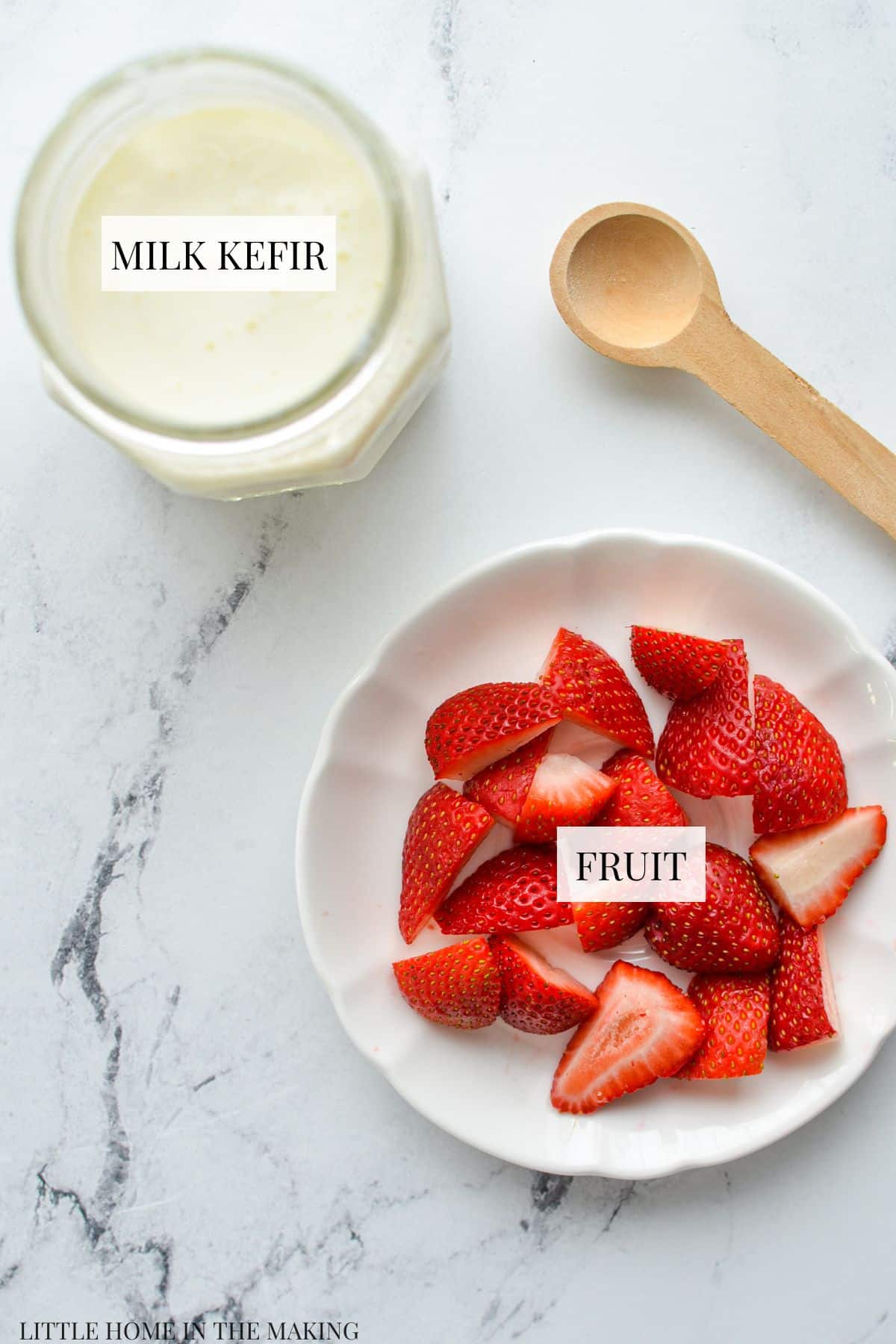
- Milk kefir: You can use either homemade kefir (check out my tutorial for making milk kefir at home), OR store bought kefir. If using store bought, be sure to purchase one that contains active cultures, and is unflavored and unsweetened.
- Fruit: You can use (almost) any fruit you would like to flavor your milk kefir with. There are certain fruits that react poorly with milk when fermenting (pineapple, mango, and kiwi), but most fruits will work great.
Equipment Needed:
- Glass jar: Whatever jars you use to make your milk kefir, you can use for a second fermentation as well. Just make sure there is enough room for both your kefir and ⅓ cup to ½ cup of chopped fruit.
- Non reactive spoon: For stirring the fruit in. You can use plastic, silicone, or wood.
How to Do a Second Fermentation of Milk Kefir
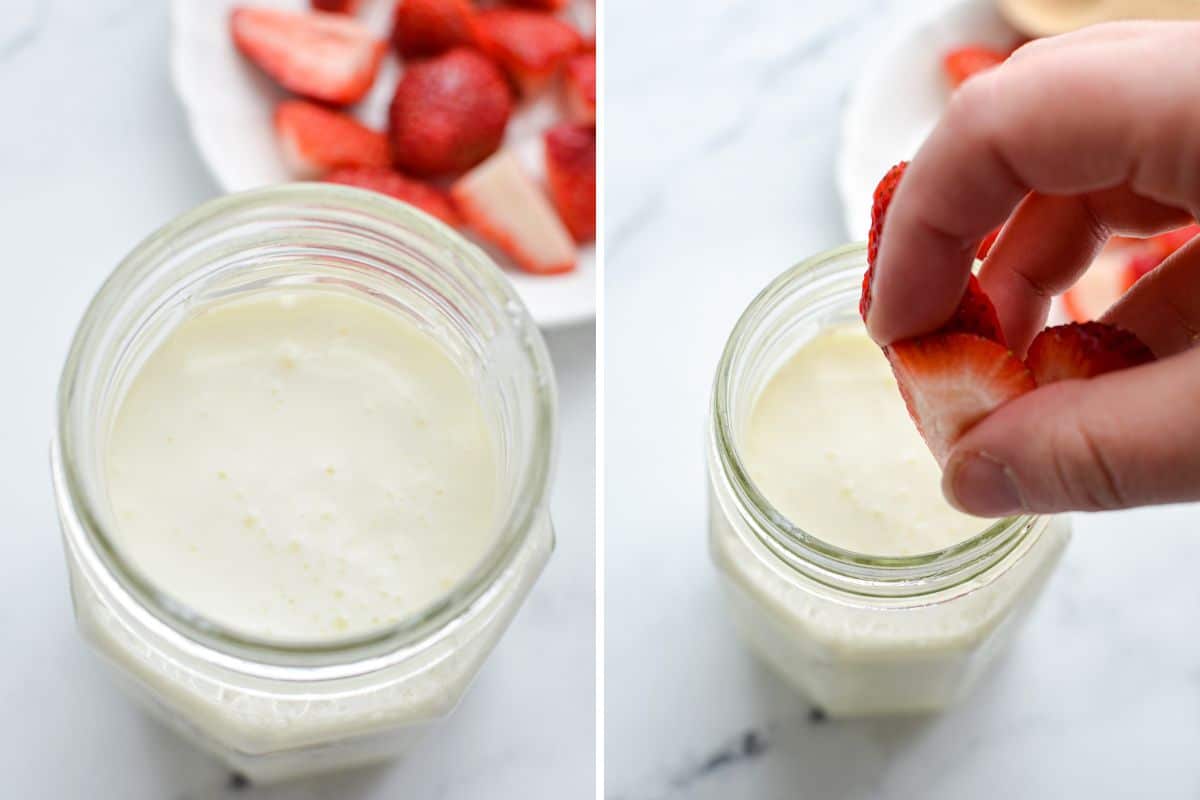
To get started, pour your milk kefir into a clean jar that is large enough to hold both the kefir, as well as the added fruit.
Then, add your fruit of choice to the jar. Chopped, small pieces of fruit will infuse more easily, and so I recommend that all larger fruit be chopped into pieces that are 1" or smaller.

Stir the strawberries into the kefir just until they are fully submerged.
Add a lid to the jar, and set aside in a warm spot on your counter out of direct sunlight. Ferment for 4-12 hours.

How long you ferment your flavored kefir will depend on how warm your house is. It will also depend on how high the sugar content is of the fruit you're using. You will need to watch your jar, looking for signs that the kefir is fermenting.
In very cold homes, you may need to ferment for up to 24 hours. Very warm homes may be as little as 4 hours.
Signs of fermentation include:
- Bubbling
- Thickening
- Pockets of whey forming
- Excess air in the jar (pickle pipes expand, and two piece lids bubble up slightly)
Once you spot some pockets of whey forming, it's a pretty safe bet that your have completed your milk kefir second fermentation. You can transfer the doubled fermented kefir to the fridge as is, or blend it to flavor the kefir with the infused fruit.
Once you've added flavor to kefir by doing a second fermentation with fruit, the shelf life shortens a bit. Try to use your kefir within one week of completing the second ferment.
Separation: A Sign of Over Fermentation

If you have allowed your kefir to ferment for too long, it will become over fermented. As long as you didn't leave it out for days, your finished kefir should still be safe to drink.
You will know that it has fermented for too long if you see a clear separation of whey and kefir. In the photo above, you can see a clear line of where the whey has separated out. In a jar that has fermented for even longer, you will see a very clear whey that may take up as much as half of the jar.
There is nothing harmful about this separation, and it can happen very quickly if your home is very warm OR if you have added fruit with a high sugar content.
What do I do if my milk kefir has over fermented?
If your kefir has over fermented, you can do a few things.
- Strain off the whey and make a sort of kefir cheese with the curds (this works best for plain kefir, rather than flavored).
- OR you can drink it. Separated kefir is perfectly fine to use in smoothies, or drink on its own, even though it may be on the sour side. Shake it vigorously with a lid, and the layers should combine easily. Place in the fridge, and shake again before using in a kefir smoothie.
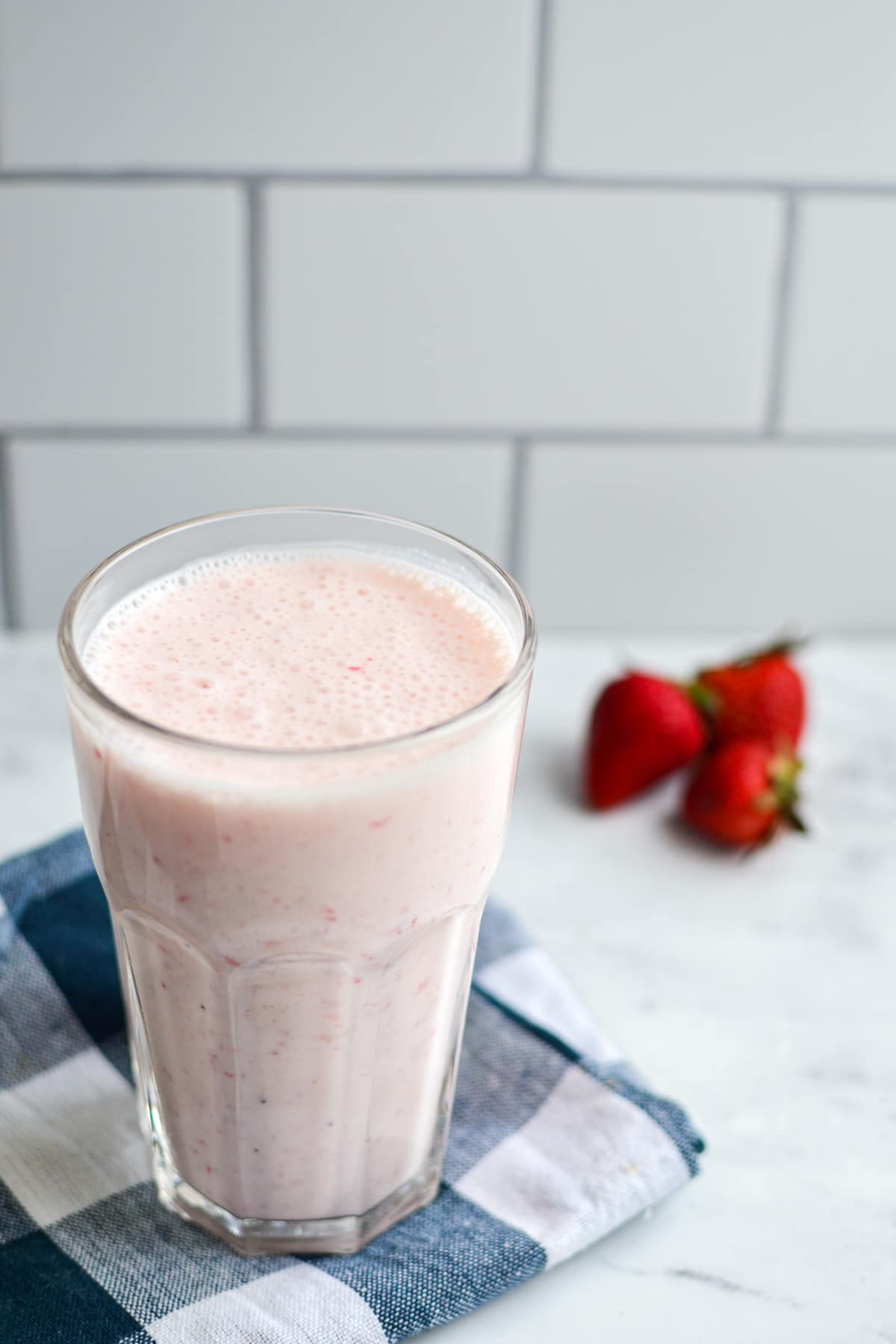
Flavoring Kefir with a Second Fermentation
There are several ways you can flavor your milk kefir. One involves making a kefir smoothie with your flavoring of choice, and another is through the process of fermentation. The fermentation method is known as a second fermentation, and creates a drinkable, flavored kefir that can either be sweetened or unsweetened.
If you are planning on sweetening your milk kefir, I recommend that you do so after the second fermentation has been completed. This is because the sugar content of sweeteners can cause rapid and unpredictable fermentation.

Here are a few of the most common flavors added through the secondary fermentation:
- Strawberries: Add ⅓-1/2 cup of chopped fresh or frozen strawberries for every 2 cups of milk kefir.
- Blueberries: Add ¼ cup of wild blueberries, or ½ cup of cultivated blueberries for every 2 cups of kefir. You can use fresh or frozen, according to your preference.
- Banana: Use a half of a large banana, cut into slices, for every 2 cups of milk kefir.
- Lemon: Add ½ of a lemon, peel included, for every 2 cups of kefir. Cut into slices or quarters.
- Fruit: Any fruit that does not react poorly with milk can be used. ⅓-1/2 cup of 1" pieces is a good guideline when making substitutions.
- Honey: Because of rapid fermentation, I would not recommend that you include honey prior to fermentation. Instead, sweeten your kefir with honey after and refrigerate immediately.
- Chai Tea: Add 1 chai tea bag (staples removed) for every 2 cups of liquid.
Using Frozen Fruit

If you would like to use frozen fruit to double ferment your kefir, you can absolutely do that! Frozen fruit contains as much sugar as fresh fruit, and makes a great option for adding flavor and color to your homemade beverages.
Select frozen fruit that is small in size, like wild blueberries or chopped or sliced fruit. These will thaw more quickly and infuse the ferment with more flavor, more quickly.
Once the second fermentation is completed, blend the kefir with the fruit. Store in the fridge for 3-4 days, for a maximum of 1 week.
Frequently Asked Questions
The time required for a second fermentation will vary based on how warm your house is, and the sugar content of the fruit or flavoring used. The typical time it takes to do a second ferment is approximately 8-12 hours, but may vary from 4-24 hours. You will know it is done fermenting when pockets of whey have started to form and bubbles are visible.
Yes, you can add fruit to kefir! You can do what is called a second fermentation, where you strain off the kefir grains and add fruit to the finished kefir for a second round. Alternatively, you can opt to make a kefir smoothie by adding fruit, ice, and a bit of sweetener of choice such as honey, maple syrup, or sugar.
Kefir will continue to ferment in the fridge, albiet at a much slower rate. If you leave kefir grains or fruit in your kefir, it will tend to ferment more quickly than on its own, but it will continue to very slowly ferment at the cold temperature of your fridge.
You can add fruit and ferment your kefir with it, but only if you have removed the kefir grains. This is called a second fermentation, and you should never add fruit to milk that is actively fermenting with kefir grains.
Yes! Double fermenting kefir (also known as a second fermentation) reduces the sour taste, and further reduces the sugar content of the finished beverage. If you would like to add flavor and (some) bubbles, the second fermentation can be done with the addition of fresh or frozen fruit. Just make sure to strain off the kefir grains before adding the fruit.
Since fermentation continues even under cold conditions, placing your milk kefir in the fridge will result in a slow, less intense second ferment. Because of the cold temperature and slow pace of fermentation, you will need to leave your kefir for a longer period of time, and you will not get the effervescence that is common with a second fermentation at room temperature.

Milk Kefir Second Fermentation
Doing a kefir second fermentation adds flavor, color, and BUBBLES to your homemade (or store bought) milk kefir. Best of all? It can be done plain, with fruit, or with other flavorings of your choice!
Ingredients
- 2 cups milk kefir
- ¼ - ½ cup fresh or frozen chopped fruit (*see notes)
Instructions
- Add 2 cups of kefir to a medium sized glass jar with a lid.
- Add your fruit of choice to the jar, and stir to submerge the fruit into the kefir.
- Place the lid on the jar and set in a warm spot on your counter out of direct sunlight.
- Ferment for 4-12 hours, or up to 24 hours if your home is very cold. You will know the second fermentation is complete when you see bubbles and pockets of whey forming.
- Once the second ferment is complete, blend the kefir and fruit together and serve immediately, or store in the fridge for up to 3-4 days.
Notes
Homemade or Store Bought Kefir?: You can use either store bought or homemade milk kefir to do a second fermentation. You just need a "finished" milk kefir, which means that it has fermented once with kefir grains and is now thick and slightly sour.
Potential flavors:*
- Strawberries: Add ⅓-1/2 cup of chopped fresh or frozen strawberries for every 2 cups of milk kefir.
- Blueberries: Add ¼ cup of wild blueberries, or ½ cup of cultivated blueberries for every 2 cups of kefir. You can use fresh or frozen, according to your preference.
- Banana: Use a half of a large banana, cut into slices, for every 2 cups of milk kefir.
- Lemon: Add ½ of a lemon, peel included, for every 2 cups of kefir. Cut into slices or quarters.
- Fruit: Any fruit that does not react poorly with milk can be used. ⅓-1/2 cup of 1" pieces is a good guideline when making substitutions.
- Honey: Because of rapid fermentation, I would not recommend that you include honey prior to fermentation. Instead, sweeten your kefir with honey after and refrigerate immediately.
- Chai Tea: Add 1 chai tea bag (staples removed) for every 2 cups of liquid.
Nutrition Information:
Yield: 2 Serving Size: 1 CupAmount Per Serving: Calories: 118Total Fat: 2gSaturated Fat: 1gTrans Fat: 0gUnsaturated Fat: 1gCholesterol: 10mgSodium: 472mgCarbohydrates: 14gFiber: 0gSugar: 13gProtein: 11g
Nutrition information is an estimate only.
Please note that some of my blog posts here at Little Home in the Making may contain affiliate links. If you make a purchase through these links, I will get a small commission at no additional cost to you. See our disclaimer for more information.




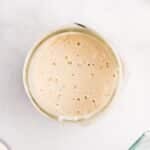






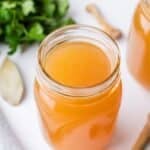




















Pierra
Hi Dolly, can I blend the fruits first and then do the 2nd fermentation? Thanks
Dolly
Hi Pierra!
You can blend the fruits separately and add them to the milk kefir before fermentation, but I wouldn't recommend blending them with the milk kefir before fermentation. Blended, pureed fruits will also ferment the milk kefir a bit faster, so once you see lots of activity, your kefir is almost done.
Ivo
Hi,
You said "...you should never add fruit to milk that is actively fermenting with kefir grains."
I wish I could flavor kefir and ALSO let bacteria eat the sugar in the fruit, so I end up consuming kefir and fermented fruit with much less sugar than it had before.
I don't mind taste changes, as long as sugar is eliminated by bacteria.
I make my kefir in the fridge with many grains (about a half cup of grains ferments my kefir in the fridge for about 2-3 days)
Why should grains ferment without fruit in the first fermentation?
How is flavor added in commercially made kefir? If it's still sweet in the store after that many days with the sweet flavor, doesn't that mean kefir is dead and stopped processing sugar, so it gets longer shelf life?
Thank you.
Ivo
Hi,
I wish I could flavor kefir and ALSO let bacteria eat the sugar in the fruit, so I end up consuming kefir and fermented fruit with much less sugar than it had before.
I don't mind taste changes, as long as sugar is eliminated by bacteria.
I make my kefir in the fridge with many grains (about a half cup of grains ferments my kefir in the fridge for about 2-3 days)
Why should grains ferment without fruit in the first fermentation?
How is flavor added in commercially made kefir? If it's still sweet in the store after that many days with the sweet flavor, doesn't that mean kefir is dead and stopped processing sugar, so it gets longer shelf life?
Thank you.
Dolly | Little Home in the Making
The second fermentation process does actually consume some of the sugar from the fruit, it's just done without grains. The idea behind not doing the first fermentation (with grains) without any added fruit is that it can contaminate the grains. But since the milk is fermented already, adding another food source (fruit) provides additional sugar for food and it continues to ferment.
Commercially, flavoring is likely a type of syrup or flavoring that is added after the culturing process.
Kandy
When you say “blend” the kefir and fruit, is this stirring by hand or in a blender? I’m enjoying your post so much.
Jane Coverdale
Hi, do I have to defrost the frozen fruit first? I know heat kills the live probiotics and I thought frozen fruit would too?
Thanks
Dolly | Little Home in the Making
It's totally fine to use frozen fruit - the coldness is diluted quickly when blending, and even freezing probiotic-rich foods doesn't destroy the benefits in the same way that heat does. For example, you could freeze yogurt or kefir and much of the different strains would still be active.
Della
What is the ideal mbient temperature to do a 2nd fernent with fruits? My ambient temp is 60F snd it has been 12 hrs. but it seems like it can ferment longer.
Dolly | Little Home in the Making
Really look and feel is the best way to know with kefir, and if you are thinking it isn't fermented enough, it probably isn't. 60F is pretty cool, so you could probably let it go another 4-12 hours.